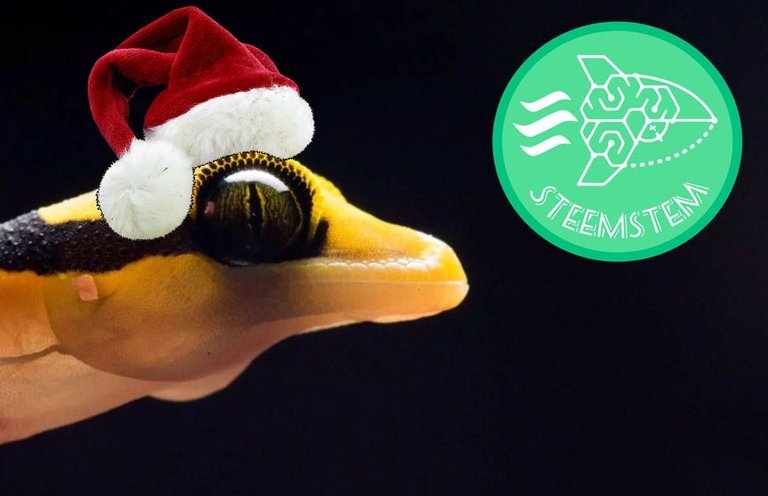A little late this week. Too much excitement with this whole SBD and STEEM thing. Even now I'm just poking STEEM with a stick trying to make it do something. But, thankfully this week has been interesting enough to keep me distracted for a while! Check out this mix bag:
Monday: New Species Galore!

A hugely comprehensive survery of the rainforests of Penang, Malaysia occurred earlier this year; a massive, top-to-bottom sweep of the forest canopy and floor. They looked through tree tops and caves, under the shrubs and in the kitchen sink. 117 scientists in all.
This huge effort is to help get this mostly unknown forest added to the UNESCO biosphere reserve, giving it advanced protection status. Possibly no surprise to anybody, a whole bunch of new species were discovered - I'll see about finding one to look into for my NEW DISCOVERIES series - including a scorpion, bacteria, flies and a range of flora.
The area is considered pretty fragile, given that it's near a vast metropolis, and also surrounded by vast efforts of deforestation. Ahh, humans.
But that's even more the surprise that so little is known about the area, and all the more reason why the scientific horde ought to have done what they did; log 1,400 species or more.
The scorpion was particularly interesting, belonging to a group called ghost scorpions, one of the oldest lineages on earth, and yet had never been noted by science before.
Noted, but incredibly rare was the flying lemur which, if anything else, adds a bit of 'ooooo' to the findings, increasing the chances of interest in the UNESCO nominations. They also managed to record its communicating conversations which may give later insight into how they go about their day.
Processing all these new species, rare species and also known species new to the area, will take months and in the case of the new species, sometimes years. To speed up this process, the scientists logged all their findings on a public app, iNaturalist designed to explore and share observations and discoveries. Something I'm gonna download before I go to bed tonight!
To see some more HD shots of the flora and fauna, click here. Trust me, they're awesome
Tuesday: UNLIMITED POWER!!! ... Eventually. Maybe.

Pretty much like this
A few days ago in my post explaining how Santa actually works, I suggested fusion-powered drones to do all the heavy lifting and delivering, since batteries as we know them now will very likely come nowhere close to providing us with our power-hungry needs. I noted that the French had been working on a fusion reactor for years.
By pure coincidence, a milestone was hit and reported on, something I picked up on the very next day; Construction has hit the half way point. This is pretty good given that they've been hit by huge financial costs unexpected at first, reaching a hefty $23.7 billion to date.
Called the International Thermonuclear Experimental Reactor, or ITER, it plans to demonstrate that fusion power is an actual viable option as a source of practically limitless energy. I feel like it's been going on most of my life, but the start-up date appears to be 2025, which doesn't seem too atrocious.
The benefits of fusion would be many. It would be cheap, renewable and safe. The process of fusion would not create catastrophic chain reactions, nor does it produce radioactive waste, meaning the likelihood of another Chernobyl would be somewhere around 0%.
That being said, ITER won't actually be a power plant, it's purely an experiment. A really big, multi-generational experiment. If it can start up in 2025, it will take another decade to decide whether it actually generates more power than is put into it - the overall goal.
Taking this into consideration, it's probably going to be tough to meet deadlines. There are numerous countries involved; The USA, China, India, Japan, the EU, Korea, Russia, and they all have their political strifes and arbitrary dick-swinging to deal with. All it takes is a Donald Trump to decide their 9% share in the project needs to be pulled out so he can afford a new novelty hyper-explosive power bomb, and the project stalls. Suddenly everybody else will consider pulling out too. The project has to survive through authoritarian and democratic transformations constantly over the next few decades.
Wednesday: Space Junk solutions

You may have heard about the huge and real problem of space junk. We humans have been putting so much of it out there that the entire earth is shrouded in probably millions of metallic garbage, from full on satellites to flecks of paint. Although NASA keeps track of the big bits, larger than a couple of inches - which is pretty amazing if you think about it - the smaller stuff, millimetres in size are currently impossible to keep an eye on. There are about 20,000 baseballs and 50,000 marbles of junk up there being tracked, but millions of stuff smaller than that.
And that's pretty dangerous. A fleck of paint moving at 28,000 km/h right into your face wouldn't be too pleasant an experience, so imagine what it feels like being an astronaut in the vacuum of space!
Enter the Space Debris Sensor, a new tool installed on the ISS. This complicated little gadget wrapped in complicated film called Kapton that allows the sensor to work stably in extreme temperatures, will make a note of debris impacts on the station itself. It will:
measure the size, speed, direction, time, and energy of any small debris it comes into contact with.
This should give a better insight to the surrounding environment which will aid those on the ground to conjure up preventative counter-measures. At this point I don't see what's wrong with a big net.
Thursday: CRISPR to the rescue

Any attempt to look into science news will force your eyes on CRISPR at some point. It's big news. I won't go into too much detail as to what it is, but it's essentially a genome editing technique that is pretty modern and can lead to a whole range of fantastical - or terrifying - modifications to our lives.
Most recently, scientists have been able to modify it to treat diabetes, kidney disease and muscular dystrophy, without needing to break into DNA - epigentically.
You see, a big concern with CRISPR/Cas9, its full name, is that its somewhat ethically troublesome when you are breaking down and cutting up genes in living human beings. This can cause mutations that are unpredictable. But this new epigenetic approach gets around that.
At first one approach was to ouse dCas9, d for dead. Cas9 is an enzyme, and by using a dead version of it, it can target genomes without cutting them up. Coupling this with some molecular switches allows genes to be targeted and turned on or off.
But it's too bulky. There been no viable way to actually use this system to tiny little cells and viruses. Now, however, the latest team have managed to combine both Cas9 and dCas9 along with a variety of molecular switches and figured a way to efficiently optimize the process, and to prove its efficacy, treated a range of diseases and illnesses in mice this way!
It's more amazing than it is confusing, so You can read more here
Friday: Excitonium

This pretty much sums up my understanding of anything Quantum
Solid, Liquid, Gas. That's all I was taught in school when it came to states of matter. Why are things getting so complicated now?
Now we have plasma, Superconductivity:, Bose–Einstein condensate, super solids... what next, I hear you ask? Why, Excitonium!
This was apparently described 50 years ago, theoretically speaking, but has now been proven - and replicated 5 times.
Like superconductivity and super fluids, this state of matter has some interesting and mysterious qualities, seemingly defying reason.
Now It's really tough for me to understand, but from what I can tell, when an electron escapes a semi-conductor by jumping over an energy gap to an empty conduction band, it leaves a hole behind. There is a strange, quantum mechanical pairing between this hole and the electron. The hole behaves like a positively charged particle, attracting the particle back towards it, and this act creates an exotic particle, the exciton. Get it??
It's still nothing more than speculation when it comes to actual applications for this new state of matter, but at the very least it has unlocked a new realm of understanding in quantum mechanics, something that we really, really need. This single aspect of Quantum stuff is so beyond me I can't go into it in details, but if you think you're smart, **You can read more about it here or Read the original paper here(log-in required).
So that's it for this week, hope you learnt something new!
Images not sourced CC0 licensed

After taking three straight years of biology, I have become very interested in CRISPR. What are your personal views on the ethics behind gene editing?
Very torn indeed. Living in China, where some of the most progress seems to be happening I get a pretty dystopian outlook of the potential slippery slopes people discuss.
Given that countless girl babies get abandoned on the streets so couples can legally have another try at a boy, and given that the fuerdai population here - 'rich second generation', raised on all the wealth of their parents, but none of the actual parenting - have no idea how to function as a member of society, I can certainly see some sci-fi divide generations from now between rich designer humans and the 'low-end population' (government's actual words), that have less rights than most monkeys in India.
But in terms of current times, real world applications, I don't have any particular qualms with fighting diseases and correcting certain debilitating conditions, but regulation is gonna have to take decades for this to work properly. It's just too ahead of the human comfort zone to sit nicely for most people, i'd say.
Hmm.... This genome editing is usually a confusion to me. I don't seem to really understand it but every other thing was clear enough.. Thumbs up👍
Basically they've learnt to do non-intrusive genome editing, without cutting or damaging DNA. Pretty neat!
Ok